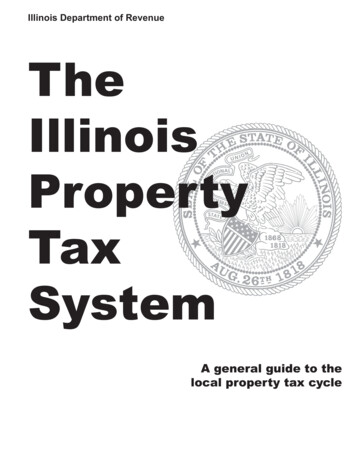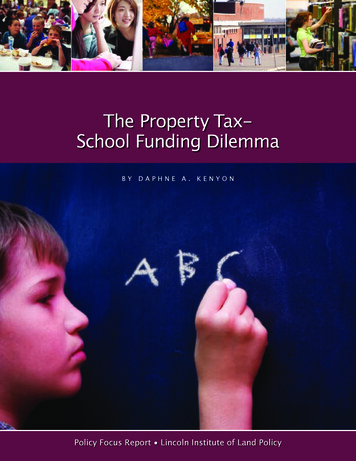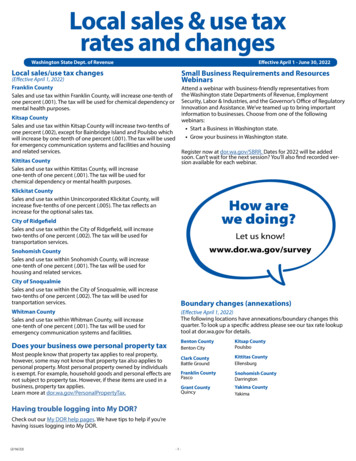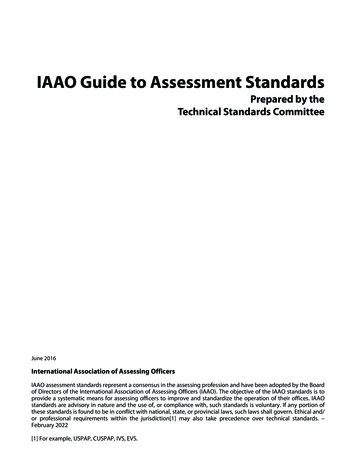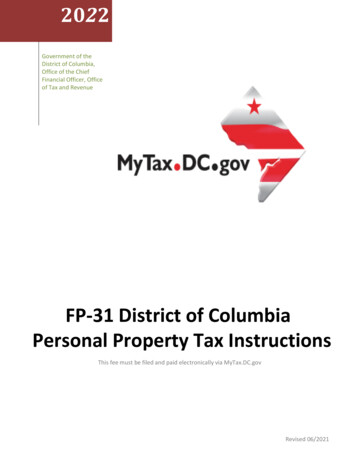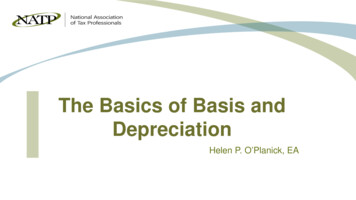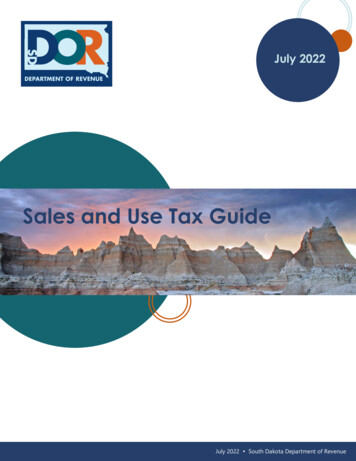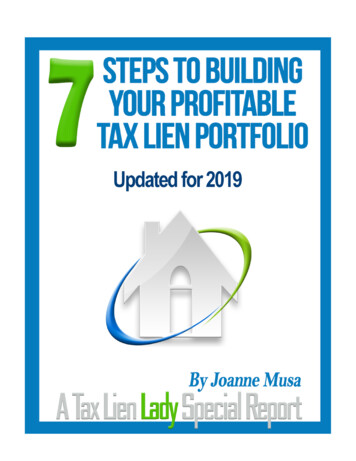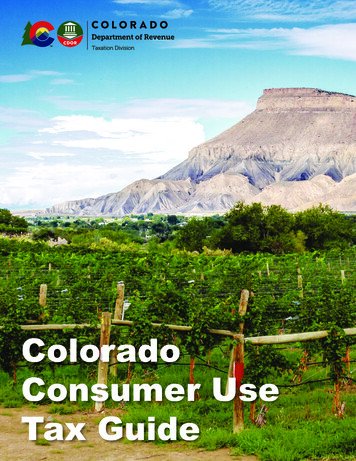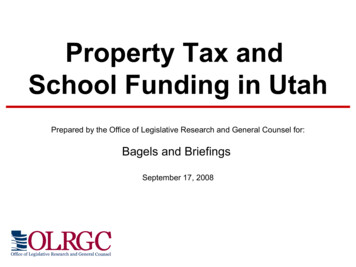
Transcription
Property Tax andSchool Funding in UtahPrepared by the Office of Legislative Research and General Counsel for:Bagels and BriefingsSeptember 17, 2008
Presentation Outline Property tax background Education funding and property tax– Basic indicators of school funding needs– School funding sources– School property taxes Tax base Tax rates Tax revenues
Presentation Outline Property tax background Education funding and property tax– Basic indicators of school funding needs– School funding sources– School property taxes Tax base Tax rates Tax revenues
Why Discuss Property Taxes Today? Property tax is on the mind of many taxpayers– Preliminary property tax statements mailed in July– Truth in taxation hearings in August– Final 2008 property tax rates set by taxing entities after truth in taxationhearings, then verified and finalized by Tax Commission– Property tax bills mailed to property owners Property tax is a major school funding source– Majority of all property tax statewide goes to fund schools– General implications for overall education funding, including state budgetimplications– Implications when a new school district is created Taxable values have increased rapidly in recent years– Rapid value increases in existing property– Significant value growth from new property development
Three Major State & Local Revenue SourcesIncome, Property, and Sales TaxFY 1982 to FY 2007 3.0 2.0 1.5 1.0 62007 31994Billions of Dollars 2.5Property TaxIndividual Income TaxSales and Use Tax (State and Local)Data Source: Utah State Tax Commission, Property Tax Division & Economic and Statistical Unit
Property TaxA Major Component ofUtah’s State and Local Government Tax SystemOther local taxes(excise, franchise, andearmarked sales tax)State corporate taxes(franchise/income, gross receipts)State transportationtaxesOther state taxes(severance, insurance,cigarette, etc.)State individualincome taxLocal property taxData Source: Utah State Tax Commission Annual Report, FY 2007State, local, and countysales and use tax
Presentation Outline Property tax background Education funding and property tax– Basic indicators of school funding needs– School funding sources– School property taxes Tax base Tax rates Tax revenues
Presentation Outline Property tax background Education funding and property tax– Basic indicators of school funding needs– School funding sources– School property taxes Tax base Tax rates Tax revenues
Why Do School DistrictsImpose Property Taxes? To understand property taxes, it is helpful toinitially consider why school districts imposethe property tax Basic answer is to provide revenue to meetschool funding needs– However, different definitions of funding “needs”exist– What are some basic measures of funding needs?
DaggettTinticPiuteRichWayneGarfieldNorth SummitKaneSouth SummitGrandBeaverJuabMorganEmeryNorth SanpeteSan JuanMillardSouth SanpeteCarbonDuchesnePark CitySevierWasatchLoganUintahMurrayIronBox ElderOgdenTooeleProvoCacheCharter SchoolsSalt eDavisGraniteJordanBasic Measures of School Funding NeedsTotal 10,0005,0000Data Source: Utah State Office of Education, Jordan School District
0(500)(1,000)Data Source: Utah State Office of Education, Jordan School DistrictCharter eNeboWeberIronCacheWasatchBox ElderDuchesneUintahPark CityMorganJuabSouth SanpeteSevierCarbonGrandBeaverSouth SummitWayneNorth SanpeteNorth Salt LakeMurrayLoganOgdenEmeryMillardSan JuanProvoGraniteJordan-EastBasic Measures of School Funding NeedsEnrollment Growth5,5005,0001 Year Change in Enrollment3-year-average Change in Enrollment3,5003,0002,5002,0001,5001,000500
Other Potential Measures ofSchool Funding Needs Different types of students––––Special educationEnglish language learnerGifted and talentedLow income Transportation / travel distance to school Capital infrastructure– Buildings (age, size, functionality, etc.)– Technology Other
Distribution of Needs and Tax Bases School needs, however defined, are very unlikely toperfectly match up with the tax base of any revenuesource on a geographic basis (school-by-school ordistrict-by-district) Examples:– Some states allow a local income tax. The distribution ofUtah’s income tax base does not align with the distributionof the student population (one basic measure of schoolneed).– Utah allows school districts to impose property tax. Thedistribution of the property tax base is not identical to thedistribution of the student population (or of the income taxbase).
Presentation Outline Property tax background Education funding and property tax– Basic indicators of school funding needs– School funding sources– School property taxes Tax base Tax rates Tax revenues
HawaiiVermontNew MexicoMinnesotaAlaskaNorth CarolinaWest ed StatesSouth ineNorth DakotaOhioColoradoNew YorkFloridaSouth DakotaRhode IslandNew JerseyVirginiaTexasMarylandNew linoisNevadaDC% of FundingFunding Source ComparisonsUtah Relies Less on Local Funding Than Many States1009080706050403020100LocalStateFederalData Source: National Center for Education Statistics
National ComparisonsMajor Education Revenue Sources by RegionData Source: National Center forEducation Statistics
How is Utah Public Education Funded?Major Revenue Sources:– Income Taxes ( 2.7 billion)– Property Taxes ( 1.2 billion)– Federal Funds ( 0.3 billion)– Dedicated Credits and Other ( 0.06 billion)Fiscal year 2008-09 estimatesData source: Office of the Legislative Fiscal Analyst, Utah State Tax Commission
Property TaxA Major Component of Utah Public Education FundingIncomeTaxPropertyTaxOtherFederalFundsData Source: Office of the Legislative Fiscal Analyst, State Office of EducationBasic levy,voted leeway,board leewayCapital outlay,debt service,other
School Property Taxas a Percent of Total Property TaxSpecial Districts11%Municipalities15%Schools 56%Counties18%Data Source: Utah State Tax Commission
School Property Tax Typesas a Percent of Total Property TaxSpecial DistrictsSchools – BasicLevy (M&O)11%12%Municipalities15%Schools – Other M&O18%Counties18%Schools – Capital Outlay /Debt ServiceSchools – Other2%Data Source: Utah State Tax Commission, State Office of Education24%
Property Tax Rates Vary by Location0.018000School DistrictCityCountySpecial Districts0.0160000.014000Property Tax 00Kanab(Kane)Woodruff(Rich)Park City(Park City)Circleville(Piute)Salt Lake(Salt Lake)Huntsville St. George Smithfield(Weber) (Washington) (Cache)City (School den)Tooele(Tooele)Data Source: Utah State Tax Commission
School Property Taxesas a Percent of Total Property TaxesSchool DistrictCityCountySpecial Districts100%School Property Tax as % of Total Property f Park City Circleville Salt Lake Huntsville St. George Smithfield Bountiful Springville(Rich)(Park City)(Piute) (Salt Lake) (Weber) (Washington) (Cache)(Davis)(Nebo)City (School District)Ogden(Ogden)Tooele(Tooele)Data Source: Utah State Tax Commission
0%AlpineBeaverBox h SanpeteNorth SummitPark CityPiuteRichSan JuanSevierSouth SanpeteSouth SummitTooeleUintahWasatchWashingtonWayneWeberSalt LakeOgdenProvoLoganMurrayCharters% of FundingMajor Revenue Sources by l Property TaxStateOther LocalData Source: Office of the Legislative Fiscal AnalystSchool DistrictNote: Data for Tintic School District unavailable
Presentation Outline Property tax background Education funding and property tax– Basic indicators of school funding needs– School funding sources– School property taxes Tax base Tax rates Tax revenues
Property Tax Bases Vary Some school districts have greater ability than others togenerate revenue through property tax– Measures of school funding needs (such as student populations)and property values do not align geographically Why do school district property tax bases vary?– Overall fair market value differences in different areas– Different mix of property types (commercial, residential, agricultural,etc.)– Exemption / valuation differences among property types Primary residences receive 45% exemption, so 55% of value taxable Greenbelt agricultural properties valued based on agriculturalproduction, not parcel fair market value Charter schools have no property tax base and cannotimpose a property tax
0%Data Source: Utah State Tax CommissionAlpineBeaverBox rayNeboNorth.SanpeteNorth.SummitOgdenPark CityPiuteProvoRichSalt LakeSan tahWasatchWashingtonWayneWeberSchool DistrictProperty Tax Base CompositionPrimary ResidentialSecondary ResidentialCommercial / Industrial (includes centrally assessed)AgriculturalVacant Land (non-FAA)Motor Vehicle100%90%80%70%60%50%40%30%20%10%
Impact of Property Tax Baseon Property Tax RevenuesSuppose 3 school districts each need to raise 1 million per year. The districts each havea different tax base from which to generate the 1 million. To generate the same amountof total revenue, a taxpayer with an identically valued home in District A will pay five timesthe amount of tax the taxpayer in District C pays, because District C is able to generatethe same revenue at a lower tax rate due to its larger tax base.Tax BaseNeeded RevenueRate Required to Generate RevenueTax impact on 250,000 primary residenceDistrict A 1,000,000,000 1,000,0000.001000 138District B 2,000,000,000 1,000,0000.000500 69District C 5,000,000,000 1,000,0000.000200 28Because school districts have different sized tax bases and varying numbers of studentsto serve, it can be difficult to directly compare taxing capacity among school districts.One method of comparison is to compute the tax base per enrolled student.Total EnrollmentTax Base per Enrolled Student8,000 125,0004,000 500,0002,000 2,500,000
Charter SchoolsTinticSouth SanpeteTooeleNeboDavisCacheOgdenSan JuanNorth SanpeteWeberSevierBox ElderAlpineJordan - WestPiuteLoganJuabDuchesneGraniteStatewide urrayJordan - lt LakeNorth SummitSouth SummitKaneRichDaggettPark CityProperty Tax Base per StudentTaxable Property Tax Base per Student 2,500,000 2,250,000 2,000,000 1,750,000 1,500,000 1,250,000 1,000,000 750,000 500,000 250,000 0Data Source: Utah State Office of Education
School District Property Tax Levies Operations Levies––––Basic levyVoted leewayBoard leewayK-3 reading 10% of basic levy– 10% of basic levy can beused both for certainoperations purposes(textbooks and supplies)and for capital outlay /certain debt servicepurposes Capital Outlay & DebtService Levies– Debt service– Capital outlay– Voted capital outlay (notcurrently imposed) Other Levies–––––Special transportationRecreationJudgmentTort LiabilityPublic Law 874 - Federalimpact aid / Title VII (notcurrently imposed)
Utah School District Property Tax RatesTax Year 20070.0100000.009000Total Other Tax Rates0.008000Total Capital Outlay & Debt Service Tax RatesTotal Maintenance & Operations Tax 0000.000000TinticTooeleSouth SanpeteOgdenNeboSan GarfieldWasatchSouth SummitCacheNorth SanpeteUintahBox ElderCarbonMillardWashingtonWeberEmeryGraniteNorth SummitIronMorganProvoMurraySalt LakePiutePark CityGrandDaggettWayneRichKaneTotal Tax Rate0.007000Data Source: Utah State Office of Education
Property Tax Base per Studentand Total Tax RateData Source: Utah State Office of Education
Current School Funding Equalization Basic Program– Utah’s basic program (WPU) in the operations portion of the public educationbudget is often seen nationally as a model of an equitable education fundingsystem– Similar students meeting qualifying characteristics are funded similarly Districts with different property tax base receive same funding level– Different student characteristics yield different funding amounts Kindergarten student generates less funding than other grades (0.55 WPU) Special education student generates more funding– Each school district imposes the basic levy – an identical tax rate statewide– Because of the equalized basic program, a large portion of the maintenance andoperations budget for schools is equalized Other Funding– Schools can generate additional revenue by imposing certain property tax leviesauthorized by statute Some state funding minimally equalizes certain other property tax levies (votedleeway / board leeway guarantee) but not equalized near the extent of the basicprogram equalization– School Building Program Foundation Program Enrollment Growth Program– Non-WPU driven programs (“below-the-line”) funded with income taxes collectedon an equal basis statewide
Components of theMinimum School ProgramVoted and BoardLeeway, 359,913,204Basic Program(WPUs), 1,840,119,735Related to BasicProgram, 857,278,121One-time programsand Other, 62,820,000Data source: Office of the Legislative Fiscal Analyst, Public Education Budget Guide
Basic Levy History 300,000,0000.0050000.0045000.0040000.003000 150,000,0000.0025000.002000 100,000,000Basic Levy Rate0.003500 200,000,0000.0015000.001000 50,000,0000.000500YearData source: Utah State Office of 8619851984198319820.0000001981 01980Basic Levy Revenue 250,000,000Basic Levy RevenueBasic Levy Rate
The Weighted Pupil Unit (WPU) The WPU is not total per-pupil spending The WPU is used to determine the cost of the basicschool program on a uniform basis for each student– 1 WPU 1 student in average daily membership (ADM)– Students in Kindergarten receive 0.55 WPUs– Specific programs generate additional WPUs, generally basedon student qualifications (special education, technologyeducation, etc.) The Legislature establishes the WPU value annually– FY 2009 WPU Value 2,577– Districts and charter schools receive basic program fundingbased on their total number of WPUs Hypothetical example:1,000 WPUs x 2,577 2,577,000 (total basic program funding)
How is the Basic Program Equalized?Hypothetical District1,000 WPUs x 2,500 per WPU 2,500,000 basic program amountProperty tax base 1,500,000,000 x basic levy (.001500) 2,250,000 property tax revenue 250,000 Income Tax (Uniform School Fund)Income Tax 2,500,000Property Tax 250,000 2,250,000
Basic ProgramTwo Hypothetical School DistrictsValue of WPUWPUsBasic program statutory entitlementNet Taxable Value (Property Tax Base)Basic levy (Tax Rate)Basic Levy Yield (Property Tax Revenue)Allocation from Uniform School FundDistrict A 2,5001,000 2,500,000District B 2,5001,000 2,500,000 1,500,000,0000.001500 2,250,000 500,000,0000.001500 750,000 250,000 1,750,000Income TaxIncome TaxProperty TaxProperty Tax
Statewide Basic Program Funding SourcesBasic Levy (Property Tax) 260 MillionUniform School Fund(Income Tax) 1.580 BillionData source: Office of the Legislative Fiscal Analyst, Public Education Budget Guide
WeberWashingtonWayneWasatchTooeleUintahTinticSouth SummitSevierSouth SanpeteSan JuanSalt LakeProvoRichPiutePark CityOgdenNorth SummitNeboNorth SanpeteMurrayMorgan 250LoganMillard 275Charter SchoolsData source: Utah State Office of ryDuchesneDaggettDavisCarbonCacheBeaverBox ElderAlpineMillionsEstimated Basic Program Funding AmountBasic Program Amounts 300Uniform School FundProperty Tax 225 200 175 150 125 100 75 50 25 0
Basic Program Funding SourceData source: Utah State Office of Education
Statewide School DistrictCapital Outlay Funding SourcesCapital Outlay Foundation Program 24.4M ongoingCapital Outlay EnrollmentGrowth Program 2.9M ongoingProperty Tax 484MFY 2007-08Data source: Utah State Office of Education
School Funding SystemRelies on Accurate Property Valuation Failure to accurately and uniformly assessproperties at fair market value distorts theallocation of school funds– With the truth-in-taxation certified rate process,undervaluation of properties in one area causeshigher taxes statewide through an increase in thecertified rate for the basic levy– In addition to basic program funding, other statefunds are also tied to property tax values perstudent, including voted/board leeway guaranteesand capital outlay foundation program So assessment practices by the TaxCommission and assessors in each countyimpact taxpayers statewide
Property Tax Revenue per Student
2008 General SessionSchool Property Tax Equalization Bills HB 1 – Basic Program– Establishes the tax year 2008 basic levy rate (estimated) SB 2 – Basic Program and Property Tax Allocations forCharter Schools– Increases the value of the WPU to 2,577– Requires school districts to provide a portion of revenue from certainproperty tax levies for charter school students residing within thedistrict boundaries SB 48 – School District Capital Outlay– Requires a partial equalization of the capital outlay property tax levywithin Salt Lake County
Theoretical Equalization ContinuumWho should pay for school costs?User ualizationOnly parentsof children inschoolsOwners ofnew homesand newbusinessesAll propertyowners withinschool districtAll property ownerswithin a countySecondaryschool feesCurrentlyprohibited bystatuteDiscretionary schoolproperty tax levies(voted leeway, boardleeway, debt servicelevy, capital outlaylevy, etc.)(same as district in all but7 counties)Partial capital outlayequalization in county ofthe first classStatewideEqualizationTaxpayersstatewideBasic levy / basicprogram, educator salaryadjustments, state pupiltransportation funds
Please feel free to contactstaff with any questions:Office of Legislative Research and General Counsel(801) 538-1032
Schools 56% Data Source: Utah State Tax Commission. School Property Tax Types as a Percent of Total Property Tax Special Districts 11% Schools - Basic Levy (M&O) 12% . Charter Schools Tintic South Sanpete Tooele Nebo Davis Cache Ogden San Juan North Sanpete Weber Sevier Box Elder Alpine Jordan - West Piute Logan Juab Duchesne Granite .
